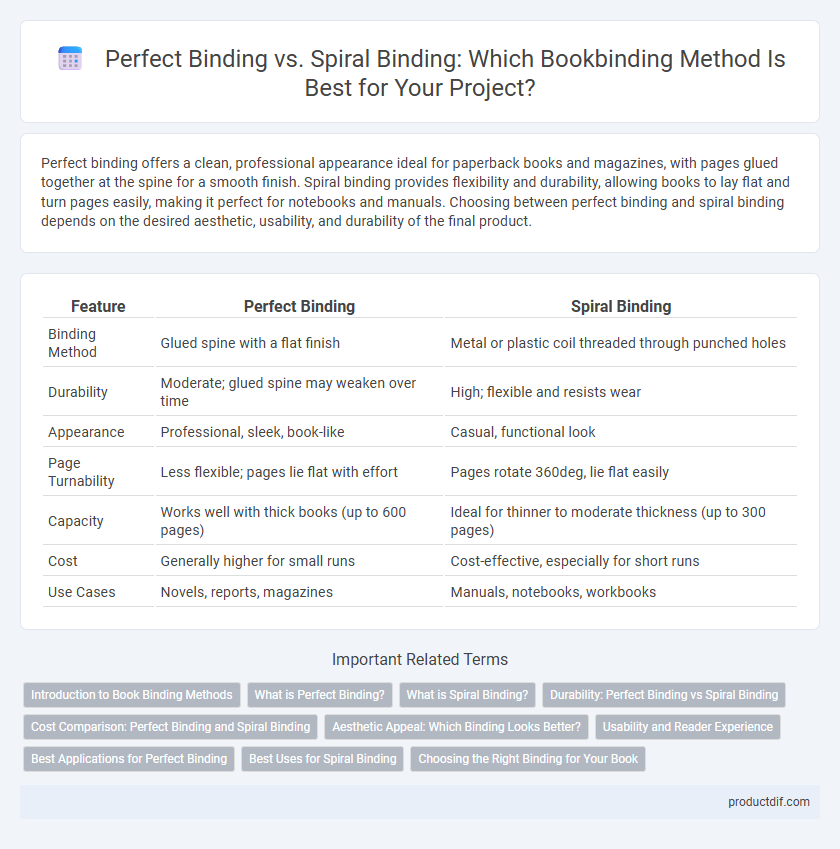Perfect binding offers a clean, professional appearance ideal for paperback books and magazines, with pages glued together at the spine for a smooth finish. Spiral binding provides flexibility and durability, allowing books to lay flat and turn pages easily, making it perfect for notebooks and manuals. Choosing between perfect binding and spiral binding depends on the desired aesthetic, usability, and durability of the final product.
Table of Comparison
| Feature | Perfect Binding | Spiral Binding |
|---|---|---|
| Binding Method | Glued spine with a flat finish | Metal or plastic coil threaded through punched holes |
| Durability | Moderate; glued spine may weaken over time | High; flexible and resists wear |
| Appearance | Professional, sleek, book-like | Casual, functional look |
| Page Turnability | Less flexible; pages lie flat with effort | Pages rotate 360deg, lie flat easily |
| Capacity | Works well with thick books (up to 600 pages) | Ideal for thinner to moderate thickness (up to 300 pages) |
| Cost | Generally higher for small runs | Cost-effective, especially for short runs |
| Use Cases | Novels, reports, magazines | Manuals, notebooks, workbooks |
Introduction to Book Binding Methods
Perfect binding offers a clean, professional appearance with a flat spine ideal for paperback books, magazines, and catalogs, using hot glue to secure the pages. Spiral binding, characterized by a durable plastic or metal coil threaded through holes along the page edge, provides flexibility for books that need to lay flat or fold back completely, such as notebooks and manuals. Both methods cater to different functional and aesthetic needs, with perfect binding suited for polished presentations and spiral binding preferred for ease of use and durability.
What is Perfect Binding?
Perfect binding is a bookbinding method where single sheets of paper are glued together at the spine with a strong, flexible adhesive, creating a crisp, flat edge. Commonly used for paperback books, catalogs, and magazines, this technique offers a professional, polished appearance and allows for full-color printing on the spine. Perfect binding is ideal for thicker publications, as it securely holds large page counts while enabling a wide printable surface area for cover design.
What is Spiral Binding?
Spiral binding is a bookbinding method that uses a continuous plastic or metal coil threaded through punched holes along the spine, allowing pages to lie flat and turn easily. This binding style is ideal for notebooks, manuals, and workbooks requiring frequent handling and durability. Its flexibility accommodates various page sizes and thicknesses, enhancing usability and convenience.
Durability: Perfect Binding vs Spiral Binding
Perfect binding offers a sleek, professional finish but is less durable under frequent use, with glued spines prone to cracking or pages falling out over time. Spiral binding enhances durability by securely threading pages with a metal or plastic coil, allowing the book to lay flat and endure constant handling without damage. For long-lasting, heavy-use publications, spiral binding is the superior choice to maintain structural integrity.
Cost Comparison: Perfect Binding and Spiral Binding
Perfect binding typically incurs higher initial costs due to the use of strong adhesive and a more complex finishing process, making it ideal for larger print runs and professional presentations. Spiral binding offers a more cost-effective solution for smaller quantities or projects requiring frequent updates, as it uses simple wire or plastic coils and faster production methods. While perfect binding provides a polished, durable appearance, spiral binding maximizes budget efficiency especially for short-term or interim publications.
Aesthetic Appeal: Which Binding Looks Better?
Perfect binding offers a sleek, professional appearance with a flat spine ideal for printing titles and logos, enhancing the book's visual appeal on shelves. Spiral binding provides a practical, casual look with visible coils, often preferred for notebooks or manuals due to flexibility rather than aesthetics. While perfect binding is favored for polished, commercial books, spiral binding's charm lies in its functional design rather than refined elegance.
Usability and Reader Experience
Perfect binding offers a sleek, professional appearance ideal for thick books and magazines, providing a durable spine that allows for easy stacking and efficient shelf storage. Spiral binding enhances usability by enabling books to lie flat and fold back on themselves, improving reader comfort and making it ideal for cookbooks, manuals, or notebooks requiring frequent annotation. Reader experience varies significantly as perfect binding prioritizes aesthetics and shelf appeal, while spiral binding emphasizes flexibility and ease of handling during active use.
Best Applications for Perfect Binding
Perfect binding is ideal for paperback books, catalogs, and magazines with high page counts, providing a professional, clean edge and durable spine, suitable for commercial printing and retail sales. This method supports full-color printing on the cover, ensuring vibrant graphics and a polished finish that enhances shelf appeal. It is best used for materials requiring long-term use and a sleek appearance, such as annual reports, manuals, and novels.
Best Uses for Spiral Binding
Spiral binding is ideal for notebooks, workbooks, and manuals that require frequent page turning and flat-laying capabilities. Its durability and ability to lay completely flat make it perfect for instructional guides, cookbooks, and sketchbooks where ease of writing and note-taking are essential. Spiral binding also supports adding and removing pages easily, enhancing its suitability for customizable project reports and presentations.
Choosing the Right Binding for Your Book
Perfect binding offers a professional, sleek finish ideal for novels, magazines, and manuals, providing durability and a polished spine for easy labeling. Spiral binding allows books to lie flat when open, making it perfect for cookbooks, notebooks, or workbooks that require frequent handling and page-turning. Selecting the right binding depends on the book's purpose, usage frequency, and desired aesthetic, balancing durability with functionality.
Perfect Binding vs Spiral Binding Infographic

 productdif.com
productdif.com